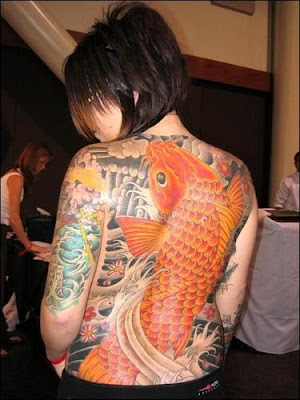Koi tattoo design | Mexican Tattoo Design
Probably surprising to many westerners is the large of amount of ancient myth that surrounds these beautiful fish in the Orient and their elevated status there. Generally known here as the brightly colored fish that are common in public ponds and fountains, carp (koi is Japanese for carp) can be found in colors that include white, yellow, gold, a deep orange, and some are even calico-colored. Particularly beautiful specimens have been known to fetch prices in excess of half-a-million dollars from private collectors who specialize in their breeding and showing. However, the koi is more than just a colorful and collectible fish. It is also one of the most popular and beautiful of Japanese tattoo symbols – a beauty which belies its symbolic meaning. Although Chinese in origin, the carp is now widely celebrated in Japan, particularly for its manly qualities. It is said to climb waterfalls bravely, and, if caught, it lies upon the cutting board awaiting the knife without a quiver, not unlike a samurai (warrior) facing a sword. This theme dates back to ancient China, where a legend tells of how any koi that succeeded in climbing the falls at a point called Dragon Gate (on the Yellow River) would be transformed into a dragon. Based on that legend, it became a symbol of worldly aspiration and advancement. Eventually, the stoic fish came to be associated with so many masculine and positive qualities that it was appropriated for the annual Boys' Day Festival in Japan where even today colorful, streaming koi flags are traditionally displayed for each son in the family. In tattoo imagery, especially in combination with flowing water, it symbolizes much the same: courage, the ability to attain high goals, and overcoming life's difficulties.




